Climbing Ropes: How to Choose the Right One (2024 Guide)

More than any other piece of equipment, climbing ropes are the vital connection to the wall. They’re a climber’s lifeline and prevent serious accidents from occurring during climbing.
During a fall, they stretch to dampen the impact force on the falling climber, transforming what would be severely harmful impacts into soft catches. Needless to say, it’s essential to get a good rope (or ropes) to match the style of climbing you practice.
A Brief History of Climbing Ropes
Nowadays, we’re lucky with the technology available to us as climbers. Soft and dynamic ropes make falling a safe and even exhilarating experience. So much, so that “victory whips” (intentional falls) are a thing! However, this was not always the case.
Early alpinists used ropes made of hemp and flax; these were much less durable than modern ropes. Also, they weighed more and became frustratingly twisted during use due to their design. Most importantly, early climbing ropes were not dynamic at all. As a result, they would not soak up the force of a fall and could easily lead to injury.
Climbers in this era simply had to adopt a “do not fall” mindset.
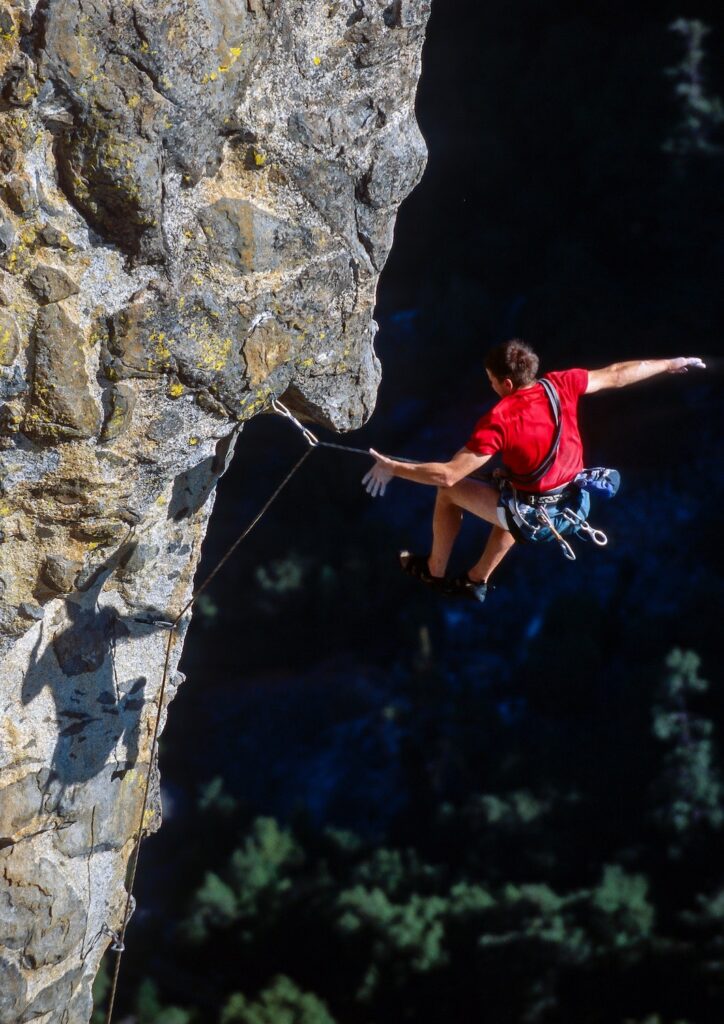
Modern climbing ropes
Luckily, the days of dubious quality climbing rope are behind us. Climbers now have a plethora of options from many different rope manufacturers available to choose from. As niches within the climbing world have emerged, so have specific ropes meant to excel in different applications.
You can now choose between climbing ropes of varying diameters, single ropes, half and twin ropes, and static ropes for hauling and rappelling. Different rope systems have different pros and cons. For example, a thicker rope is generally more durable than a thinner rope, but it weighs more.
We will go into more detail below about which ropes work best for different climbing disciplines below. All climbing ropes should be certified by the UIAA (International Climbing and Mountaineering Federation). They should bear these safety ratings on both ends when new. This means that it has been professionally tested to ensure that the rope stretches adequately and that it can really withstand the impact force generated in a serious fall.
Rope Construction
Every modern climbing rope is constructed of two main components. The interior is called the kern. It’s made up of many individual nylon fibers twisted in a spiral shape. This spiral shape is what gives dynamic climbing ropes their stretch.
The outer sheath (also called the mantle) is made up of more nylon threads woven around the core. While the inner layer provides elasticity, the outer layer shields the rope and makes it abrasion resistant.

What are the different types of climbing ropes?
There are three widely accepted rope systems used across all climbing disciplines, from simple top roping to alpine and ice climbing. Each system is distinct in terms of how the ropes are attached to the wall. However, certain ropes will work well in multiple systems.
Single Ropes
By far, the most popular and simplest setup is a single rope. It’s exactly what it sounds like: one rope running between the belayer and leader, providing protection through dynamic elongation. A single is probably the best choice for your first climbing rope.
Single ropes work with virtually all belay devices, and they make it much easier to learn rope management than with two rope systems.
Many modern single ropes are triple-rated. This means you can use them as both half and twin ropes as well as on their own.
Single ropes are the most popular choice for sport climbing routes. They are also the only ropes used in indoor gym climbing. While they are not the only system that trad climbers use, they are still popular due to their ease of use.
Usually, single ropes come in thicker diameters compared to double and twin ropes. However, finding a single rope with diameters below 9.8 mm is increasingly common.
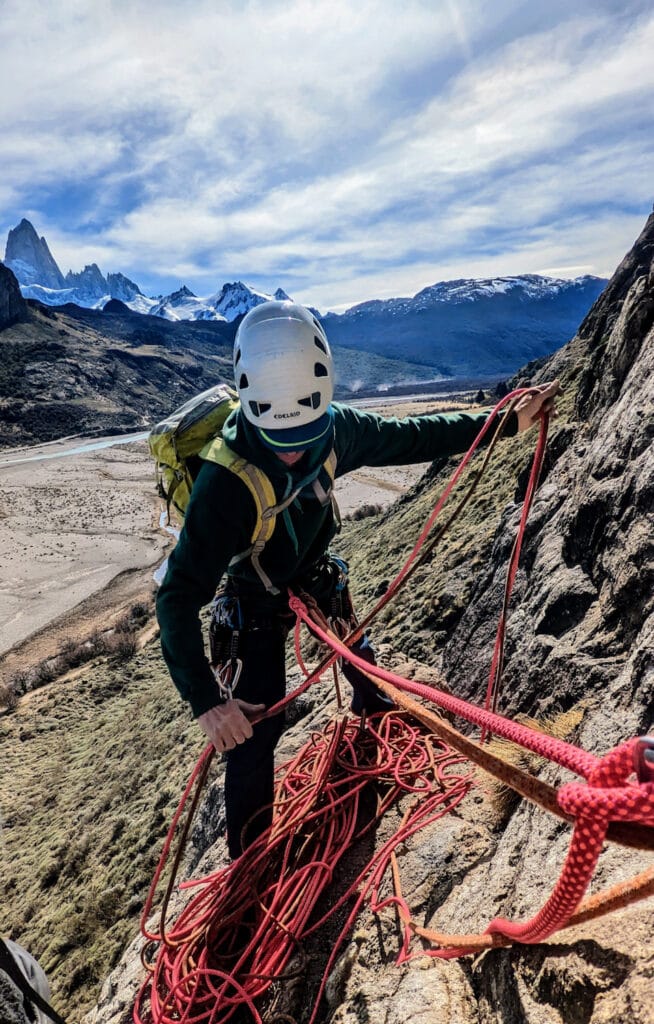
Half Ropes
Double ropes (also called half ropes) are arguably the most popular two-rope system. That’s because they offer the distinct advantage of allowing climbers to clip each rope independently. This helps minimize rope drag while lead climbing, especially on wandering routes that are difficult to extend properly with a single rope.
Double ropes are more difficult to belay with when compared to single ropes. However, they allow for a leader to belay two followers when multi-pitch climbing. It’s common to see half ropes in trad climbing, alpine climbing, and any time a team of three wants to climb multiple consecutive pitches.
For rappelling
When climbing with two ropes, it’s common to tie them together when abseiling. This way, each length of rappel is doubled. Note that you cannot use a Petzl Grigri or any other auto-locking style belay device with double ropes. Indeed, they only allow a single rope to enter. Instead, you must use a plaquette-style belay device such as a Black Diamond ATC or Kong Gigi to accommodate the two ropes.
Even though it’s very handy to be able to lower the total rope length with a pair of doubles tied together, remember that you need to pull the ropes once the rappel is done. It’s easier to get longer ropes stuck during this process.
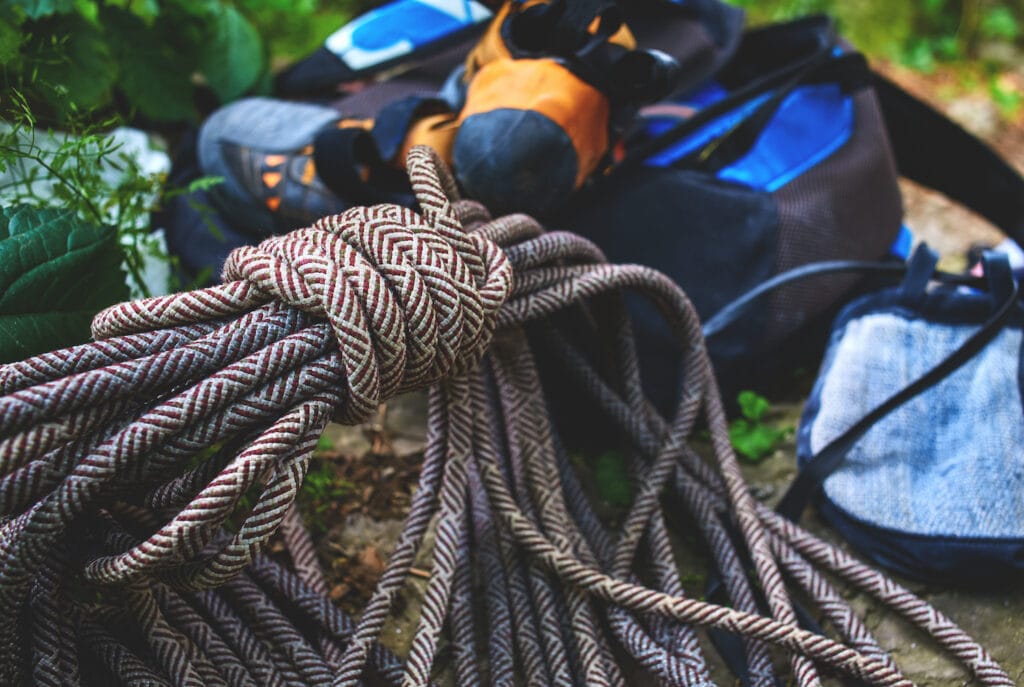
Twin Ropes
Twin ropes operate similarly to double ropes. The key difference is that they must both be clipped in to the same piece of protection. This means that they don’t offer the same advantages as double ropes when climbing wandering routes. Compared to doubles, twin ropes are usually skinnier and lighter.
Most often, you will see people using twin ropes when ice climbing or mixed climbing, on routes where rope drag isn’t a big concern. The two ropes provide extra security in case an errant crampon or pick placement damages or cuts a rope. Since each piece of protection is clipped with both ropes, there’s no way a rope can get cut while the other is dangerously run out.
For rappelling
Just like double ropes, twin ropes can be tied together to extend rappels. Because they are so skinny, twin ropes offer more dynamic elongation than other types. When the rope stretches more, the force put on protection is lesser. This is especially important when using marginal pieces of protection like ice screws. When choosing a twin rope, consider if you will be climbing in wet conditions and if you will need to get something with a dry treatment.
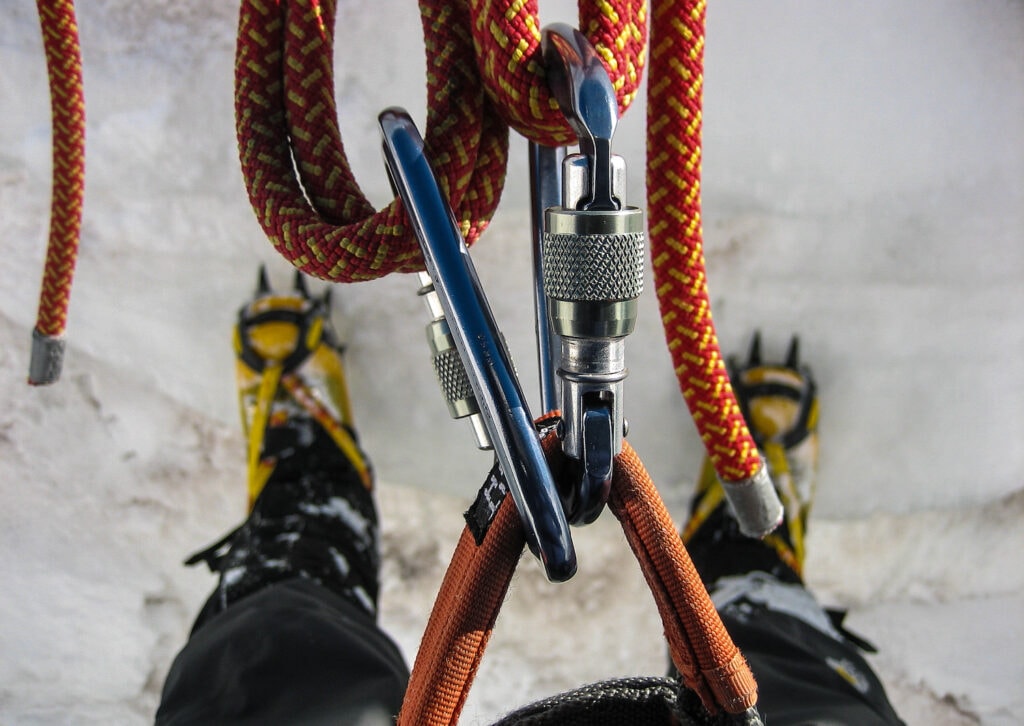
Static Ropes
It’s also common to see climbers using static ropes on larger objectives like big wall climbing and in alpine environments. Static ropes have little to no stretch, meaning they don’t provide the dynamic elongation that other climbing ropes do.
It’s important to note that you should never lead climb on a static rope, and the consequences for doing so could be fatal. Instead, static ropes are used as “haul lines” for getting bags full of gear up to the top of the pitch without carrying it on your back.
Static ropes can also be used alongside a single dynamic rope to extend rappels. On high-altitude climbs, guided trips, and aid climbing, climbers also use static ropes as fixed lines because they are easier to ascend with a device.
For more details on the different rope types, check out our guide: Single vs. Half vs. Twin Ropes.
Climbing Rope Characteristics
Apart from the type of rope you’re using, there are a variety of different features and characteristics that come into play. This can help to explain why some ropes may look nearly identical but vary dramatically in pricing.
Climbing Rope Diameter
Climbing rope diameter is a key characteristic that will determine a lot of things. Modern ropes come in diameters ranging between 7-11mm, with most hovering around 9.8mm. Thicker ropes are generally more durable and handle easier, making them favorites for beginners and those who are climbing and top roping in places with short approaches.
Skinnier ropes are less durable but weigh less, making them good mountaineering and ice-climbing choices. Rope diameter is a key factor when it comes to the overall weight. Thinner ropes are always lighter than thick ropes. A skinnier rope also has more stretch, which will help to lessen the impact force on marginal pieces of protection.
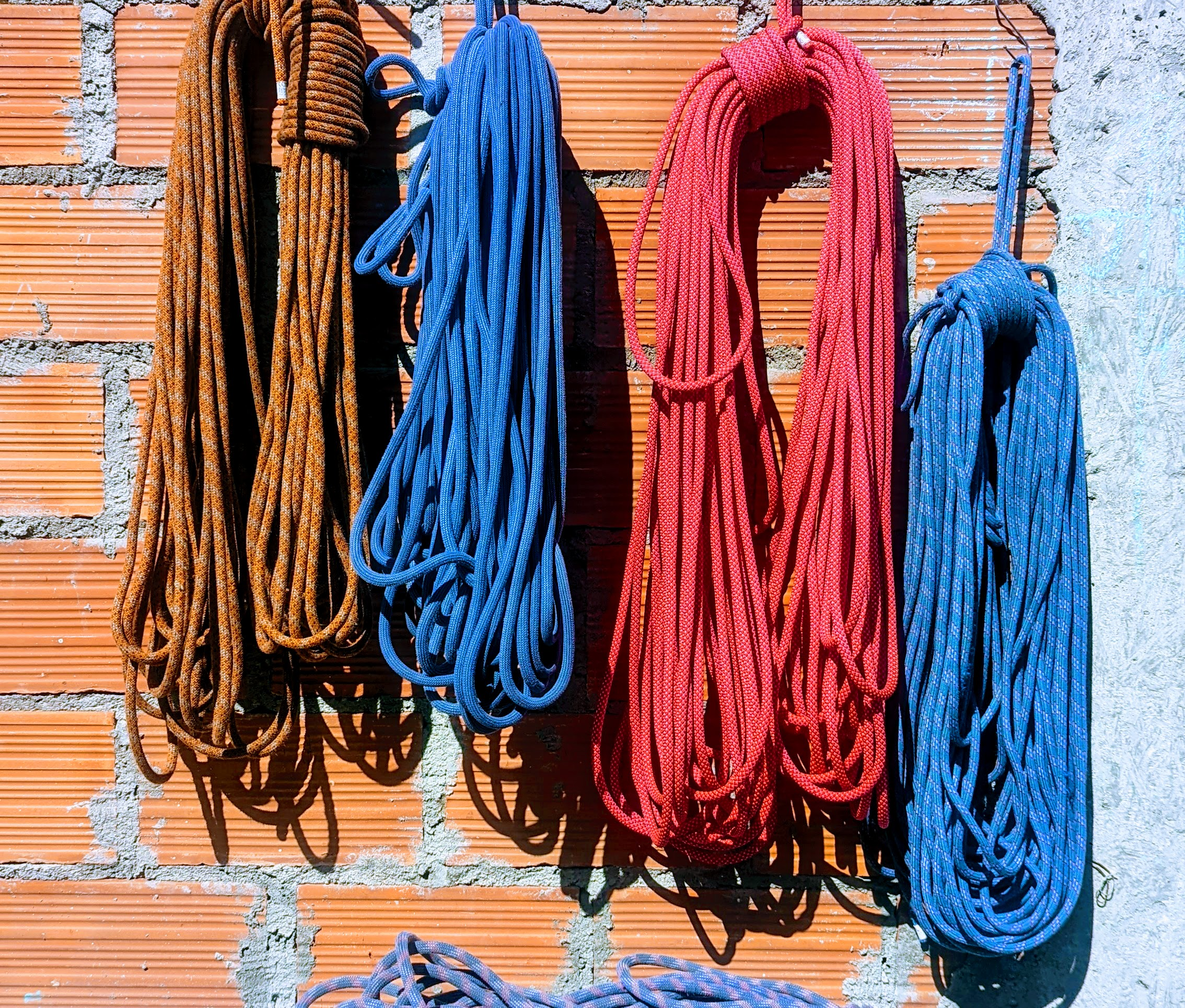
Rope Length
The length of a climbing rope will determine how long you can go before needing to build an anchor and how long a rappel you can do. The most common length of climbing rope is 60 meters. This allows you to safely rappel off most single-pitch sport climbing routes. It’s also possible to buy 70 and even 80-meter ropes to do longer rappels and maybe even combine multiple pitches.
There are other more niche lengths that ropes are available as well. Indoor climbing gyms will often have 100-meter ropes because there is no need to carry them around, and they can be cut down when needed.
For glacier travel, it’s common to see 30 and 40-meter ropes being used to save weight. If you plan on doing outdoor climbing at a nearby crag, it’s a good idea to consult an experienced climber or guidebook to determine what length is best for you. A longer rope may seem appealing, but remember that ropes tend to get stuck more often on long rappels. Also, the extra 20 meters will increase the total rope weight drastically.
Rope Markings
A standard rope will come in a solid color with markings at each end that display the rope length, diameter, fall rating, static elongation, and dynamic elongation. Nowadays, it’s also common to see ropes with a middle mark made using dye or differently colored threads. This helps climbers know when they have reached the right spot to begin rappelling from. Also, it alerts leaders when they have used half the rope.
Some ropes also come in bicolor/bipattern designs. This serves the same purpose as having a middle mark, but it’s easier to see and doesn’t wear off. It’s also possible to buy a specialized marker from Sterling that you can use to make a middle mark at home. Using a sharpie or other permanent marker is not advisable, as the dye can damage the rope’s core.
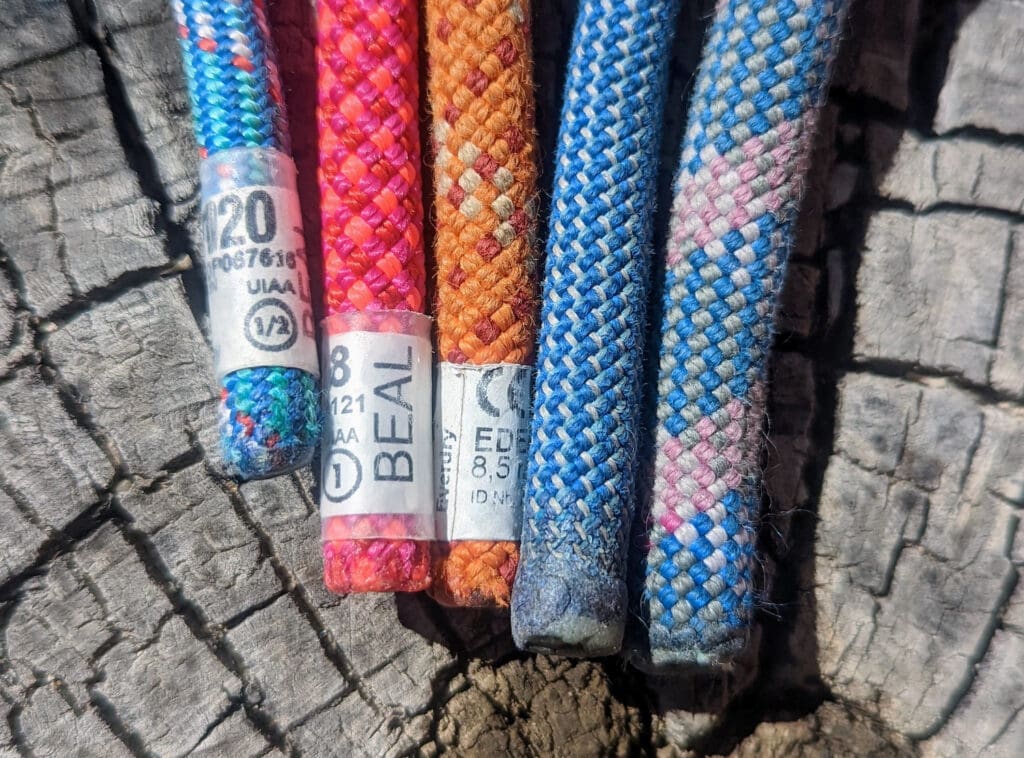
Dry Treatments
Some ropes are made with a special dry treatment that makes them less susceptible to water absorption. Dry-treated ropes have either a core, sheath or sometimes both that feature a dry treatment that sheds water easily. These ropes are designed to be used in ice climbing and on alpine objectives where routes are often wet.
When a rope gets wet, it loses its stretch. Rope stretch is, of course, an integral part of its function of reducing impact forces to gear on the wall and on the climber themselves. Wet ropes can also freeze solid. This makes the rope stiff and even unusable in serious cases. If you don’t plan on climbing in icy or alpine environments, there’s little reason to invest in dry-treated ropes.
Unicore Ropes
New technologies in dynamic climbing rope are still emerging. One of the more promising developments in the last few years has been the appearance of unicore ropes.
Usually, ropes are constructed with completely separate sheaths and cores. This can lead to what’s known as “sheath slippage,” where the outer layer stretches out while the core bunches up. Ropes with sheath slippage suffer from reduced performance.
It’s now possible to find some ropes which have been woven together so that the core and sheath are inseparable. This protects against sheath slippage and allows climbers to use ropes with damaged sheaths for slightly longer without needing to isolate the damage with a knot (such as on long multi-pitch climbs where passing the know would be troublesome).
Rope Care and Management
At the Crag
A good rope will last much longer if you care for it properly. One of the fastest ways to destroy a rope is with dirt, sand, and other particulates. Small particles can work their way into the rope and destroy the softer inner fibers of the core.
Avoid stepping on the rope! Rock climbing shoes can pick up sand and other debris, which can then be ground into the rope. Investing in a rope bag is a good idea to keep the rope from having direct contact with the ground.
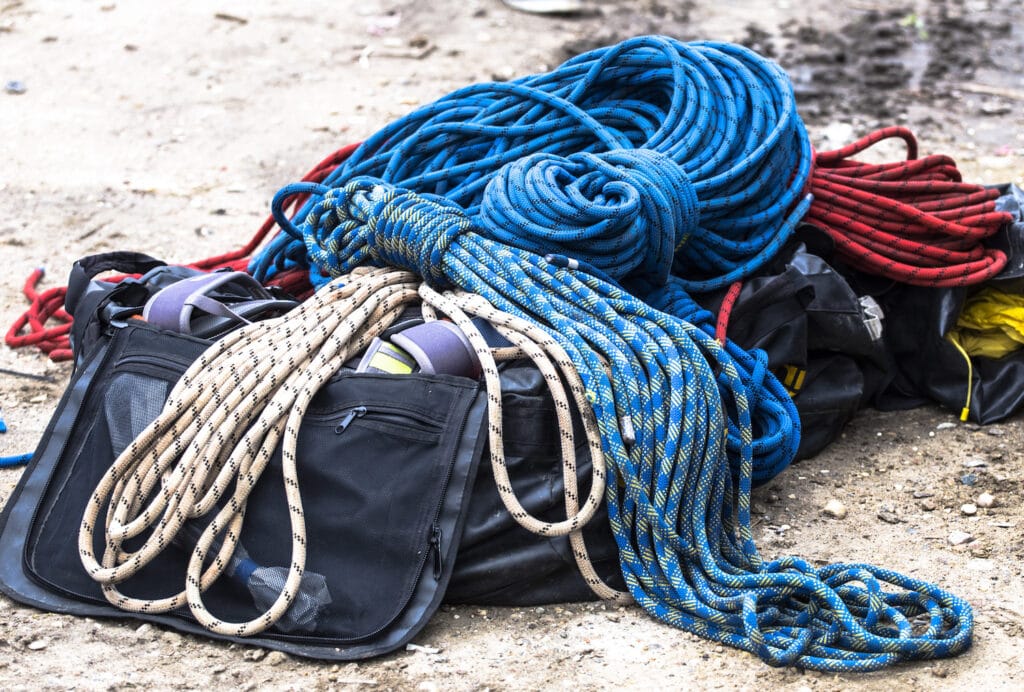
When you are climbing, keep an eye out for sharp edges and try to avoid having the rope run over them. If you are top roping and it is unavoidable, consider bringing a section of hose or PVC that you can slide over the rope to protect it if it runs over an edge. Periodically inspect belay devices and carabiners to check for burrs that could damage your rope.
Always attach weighted ropes to carabiners, never directly to the webbing. A few meters of weighted rope running through a sling can produce enough heat to cut right through it. Routinely inspect your rope at the end of the day to make sure it hasn’t sustained any damage.
At Home
Always store your rope in a cool and dry place, away from direct sunlight. Even a dry-treated rope will degrade quickly if it is stored in a humid environment. Just like at the crag, keep your rope away from dirt and dust, which can work its way into the sheath and damage the rope from the inside. A popular option is to hang your rope on the wall, where there isn’t much dirt flying around.
Depending on where you climb, it may be beneficial to occasionally give your rope a bath. Not only will this make the rope look clean, but it will also extend its life by removing dirt particles, and you will end up with a lighter rope when all is said and done.
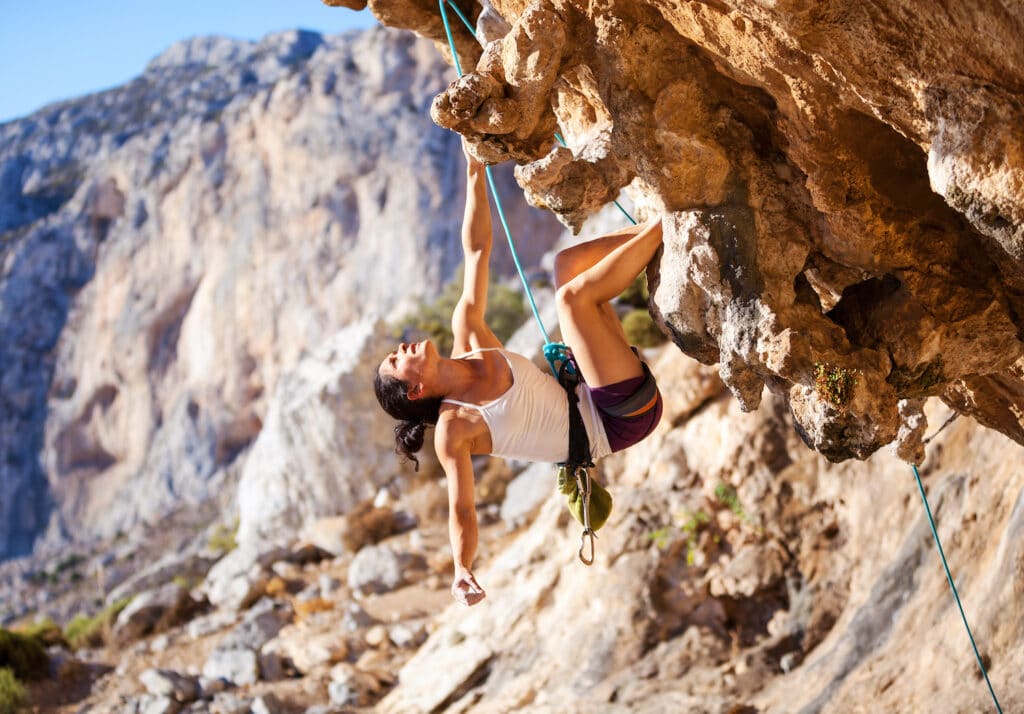
Keep an eye on the condition of your ropes. Often times it’s possible to use a rope for things like fixed ropes or top rope climbing before they are fully retired. Be mindful that thick ropes tend to last longer than skinny ropes. Once a rope is fuzzy, you shouldn’t take it on any climbs where you might expect a serious fall.
Once you reach the UIAA fall rating for a rope (defined as a factor 1.77 fall, or a “huge whipper” in dirtbag terms), you should retire the rope permanently. Remember that the rope is your number one lifeline as a climber. Rope failure is catastrophic and should be avoided at all costs.
The Best Climbing Ropes for Your Needs
What are Your Needs?
If you are new to rock climbing, a single rope with a high fall rating and a large diameter is a good first climbing rope. It will work well for top-roping, sport climbing, and going to the gym. Thicker ropes tend to inspire more confidence which is a great help to beginners. Also, it’s much easier to learn to belay using one rope.
As you begin to climb different styles of routes in more varied terrain, it’s common to have multiple dynamic climbing ropes as well as a few static lines. With time you may find that you have a preference between single and twin ropes. Usually, climbers in areas with wandering routes prefer the latter.
The longer the approach to your climb, the more you will appreciate thin ropes for their weight savings. For alpine climbing, mountaineering, and ice climbing, thinner ropes with a dry treatment are worth the extra cash.
There’s no reason to buy a skinny rope if you only intend to use it for top roping. Aside from the fact that it won’t last as long, the skinnier the rope the more static elongation it has, which makes it hard to rest on your project without losing precious progress. A thicker rope handles better as well, making learning to belay and tie knots much easier.
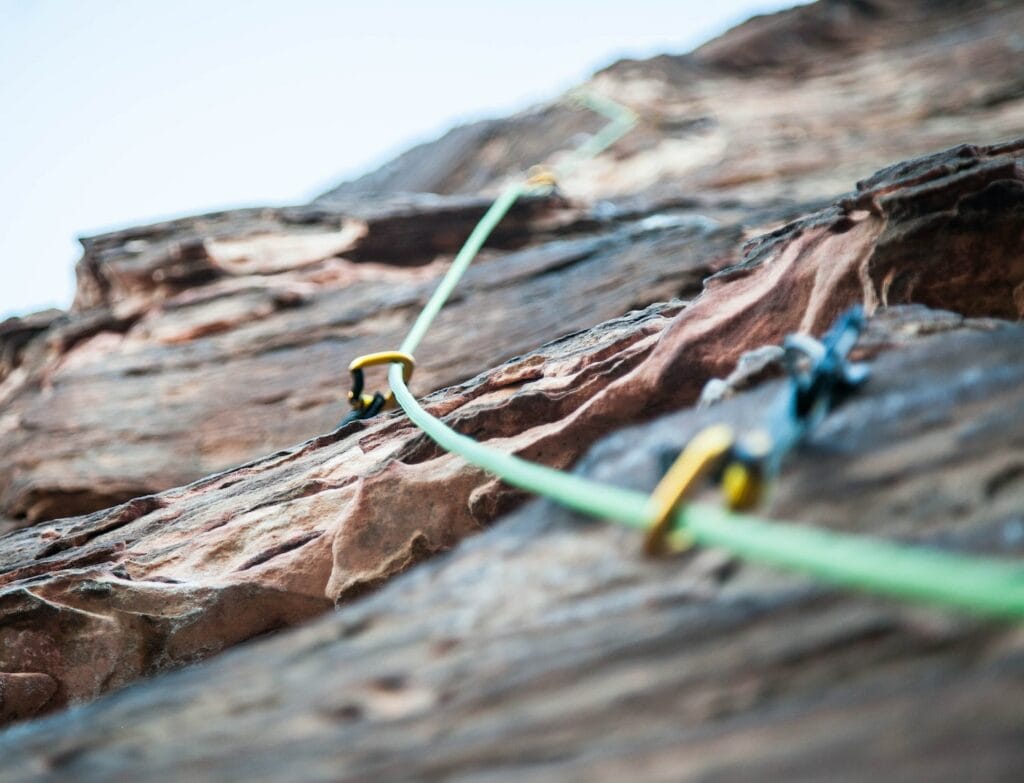
Getting started
Your first few ropes should all be dynamic climbing ropes. In fact, the only time to consider getting a static rope is if you are doing big wall climbs that require hauling gear and jugging up the rope.
A system with two ropes (usually half ropes) is great for when you begin trad climbing. Look for a lighter rope since you will now be carrying two of them. Half ropes should have the same diameter to make belaying and tying together easier.
Make sure that you use the appropriate rope for the belay device you are using. Certain belay devices work better with skinny ropes and vice versa.
Conclusion
As we said before, there are a bunch of great ropes available for all types of climbing. Because of the diversity of styles, there is no single “best climbing rope.” If you are new to rock climbing, don’t worry too much about making the perfect choice or things like climbing rope weight. Instead, buy a durable and thick rope that you can use to learn the basic maneuvers. If you are a more experienced climber looking for a rope to match a specific style, do your research beforehand. If possible, talk to other climbers knowledgeable about the route or area(s) you plan to visit. Part of the beauty of climbing is learning to deal with the many variables that come into play when dealing with the forces of nature. Have fun and be safe!
